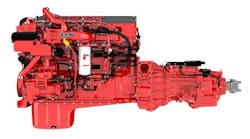Jacobs Vehicle Systems, a manufacturer of heavy-duty diesel engine retarding systems and valve actuation mechanisms, has launched a new 2-Step Variable Valve Actuation (VVA) system. By enhancing performance and efficiency across an engine’s operating range, the company says, 2-Step VVA can help engine manufacturers further improve fuel consumption and reduce tailpipe emissions, as well as deliver a range of other benefits.
The introduction of 2-Step VVA is a progression from Jacobs’ VVA intake and exhaust system, which has given major engine manufacturers more than two decades of reliable service. The new system’s relative simplicity reflects years of research and development on flexible VVA to yield an optimized two-position system that provides a large portion of the benefits in a more cost-efficient way.
2-Step VVA provides the combustion engineer with the ability to optimize valve timing at two operating points instead of the traditional single-timing option when they are driven from a fixed cam.
“By simplifying our variable valve technology, we have made a commercially desirable trade-off, only slightly reducing some of the performance benefits of fully-flexible VVA but greatly reducing calibration complexity and cost," said Steve Ernest, vice president of engineering and business development. "Jacobs offers tailored solutions based around an individual customer’s engine architecture and the problems they are looking to solve. We’re giving engine designers the ability to add some VVA flexibility without having to make significant base-engine changes.”
Jacobs has many years’ experience of opening and closing valves to enable engine braking. As market demand grew for increased fuel economy and exhaust gas after-treatment control, it was a logical progression for Jacobs, both in engineering expertise and commercial positioning, to also offer customers similar valvetrain flexibility during positive power.
Many small but cumulatively-significant performance benefits
Thousands of hours of successful engine testing, on the bench and in vehicles, have shown the benefits of 2-Step VVA.
Early or late intake valve closing reduces fuel consumption, optimizes compression ratio versus load, improves transient response and start-up, and improves emissions by keeping the after-treatment system hot during low load operation.
Early exhaust valve opening enables faster warm-up of the engine and after-treatment system, improves transient turbocharger response and emissions by keeping the after-treatment system hot during low load operation. It can also be an in-cylinder solution for helping with diesel particulate filter regeneration by replacing expensive and low-reliability exhaust heaters and dosers.
Internal exhaust gas recirculation stabilizes cold start-up combustion, shortens engine warm-up time, improves after-treatment performance, and lowers emissions by keeping the aftertreatment system hot during low load operation. This system is available in both exhaust or intake valve opening variants, responds faster than external exhaust gas recirculation (EGR) systems, and enables the downsizing or elimination of external EGR systems.
In more technical detail: 2 Step VVA Systems
- Early intake valve closing is achieved by operating on an early closing profile main event with the auxiliary valve motion (normal closing) deactivated.
- Late intake valve closing is achieved with a late-closing cam profile activated on the auxiliary rocker arm to hold the valve open longer.
- Both early and late 2-Position VVA systems have mechanical start-up without oil pressure.
- Early exhaust valve opening is achieved with an early-opening cam profile on the auxiliary rocker arm, or lost motion system, and actuated on demand with engine oil.
- Auxiliary events for internal exhaust gas recirculation and compression release braking are conveyed in the same manner as intake or exhaust 2-Position VVA systems.
- Cylinder deactivation is also possible through the use of Jacobs’ Lost Motion Valve Bridge technology.


